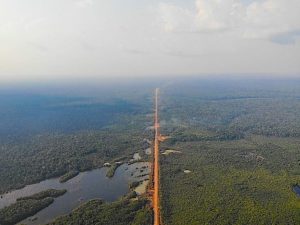On Monday 12 March, Greenpeace called for new marine protections for the ocean surrounding the Galapagos – a vital biodiversity hotspot. Specifically, the environmental campaign group pushed for governments to create a high seas marine protected zone under a new UN treaty to secure a much wider area around Ecuador’s archipelago.
Galapagos: protect the high seas
The islands sit some 1,000 kilometers (600 miles) off the mainland of Ecuador, and have flora and fauna found nowhere else in the world. The islands unique diversity of life famously inspired British scientist Charles Darwin’s theory of evolution.
Since 1998, they have been home to one of the world’s largest marine protected areas, in the eastern Pacific Ocean. The Galapagos Marine Reserve covers 138,000 square kilometres of ocean around the islands. The enormous protected area is over half the size of Ecuador and home to a vast array of species, including sea turtles, hammerhead sharks, sea lions, and marine iguanas.
What’s more, in January 2022, the president of Ecuador signed an executive decree to expand the protected area with a new 60,000 square kilometre reserve. Crucially, these reserves restrict forms of destructive fishing and extractive activities. As a result, the protected waters safeguard the fragile ecosystems of nearly 3,000 marine species.
However, Ruth Ramos of the Greenpeace Protect the Oceans campaign said that:
just outside the Galapagos protected area, industrial fishing fleets continue to plunder the oceans.
In other words, while the reserve serves as a refuge, industrial commercial fisheries threaten this marine life traveling beyond its boundaries. For instance, during 2020, nearly 300 international industrial fishing vessels pillaged this precious marine biodiversity at the border of Ecuador’s waters. As the Canary’s Tracy Keeling previously explained, in effect, this means that:
vessels from richer countries are scooping up vast quantities of fish. They do this before these animals can swim towards – and feed – people in poorer countries.
Safeguarding a “vital migratory superhighway”
Given this, Ramos said that:
We must protect this area
In particular, Greenpeace urged governments to ratify the so-called High Seas Treaty. UN member states adopted the treaty last June. It provides a framework for governments to create an expanded protected area in international waters, outside of any country’s jurisdiction.
The ‘high seas’ are oceans beyond the national jurisdiction of coastal states. Until countries negotiated the treaty, nations could only designate conservation sites within their territorial and Exclusive Economic Zones (EEZs). These are the stretches of ocean that generally extend 200 nautical miles (370 kilometres) from their coastlines.
Governments adopted the High Seas Treaty after more than 15 years of discussions to extend environmental protections to international waters. These waters – outside of any nation’s territorial and economic waters – make up more than 60% of the world’s oceans.
Once 60 governments ratify the treaty, it can go into effect after 120 days. Currently, ocean protection activists hope to reach this goal by 2025. So far, several dozen states have signed the treaty, but just Pulau and Chile have ratified it.
Therefore, as Ramos explained:
This historic treaty, once ratified, will enable us to protect a vast area of international waters near the Galapagos Islands, safeguarding a vital migratory superhighway for marine life such as sharks and turtles
Ocean “protection in action”
Currently, the environmental activist group is carrying out a scientific expedition in the Galapagos. Greenpeace said this could be the first marine protected area created since the treaty was adopted and “would remove the threat of industrial fishing fleets.” Vitally, it argued that:
It would also protect a key area of ocean that many threatened migratory species from Galapagos and adjacent marine regions must cross in order to reach key coastal habitats for pupping, nesting and feeding.
Moreover, earlier in the expedition, Ramos said that the existing Galapagos marine reserve, which is also a UNESCO World Heritage site, is:
one of the best examples of ocean protection in action. But it is still an exception in a world where only three percent of the ocean is currently fully or highly protected
Ramos said the governments of Ecuador, Panama, Colombia, and Costa Rica have taken “admirable steps” to protect the oceans in their national waters. Now, under the treaty Ramos argued that they:
have a historic opportunity to demonstrate global leadership by protecting this key area of the high seas and further safeguarding the beauty and biodiversity of the Galapagos region for future generations.
In February, the UN launched its first ever report exploring the state of migratory species. Alarmingly, it found that nearly half the species listed under Conservation of Migratory Species of Wild Animals (CMS) – a UN biodiversity treaty – were declining. Moreover, over a fifth of CMS-listed species are threatened with extinction.
Against this backdrop, Greenpeace is right to take governments to task over their failure to ratify this crucial treaty. A high seas protected area in one of the world’s most critical marine biodiversity hotspots could pave the way to concrete ocean protection.
Feature image via SeaLegacy/Youtube screengrab.
Additional reporting by Agence France-Presse




